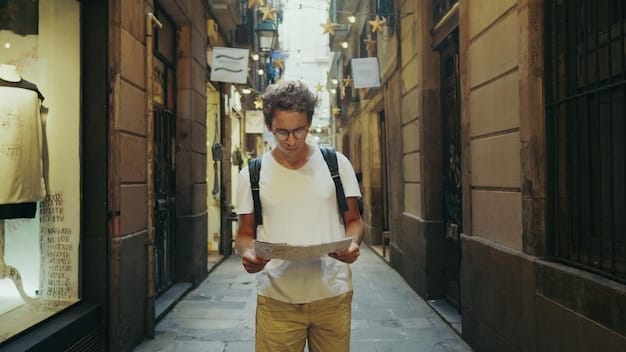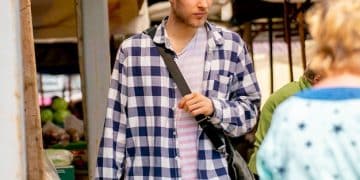Self-Defense for Travelers: Essential Techniques to Stay Safe

Self-defense for travelers involves practical techniques and awareness strategies to protect oneself from potential threats while exploring new destinations, ensuring a safer and more secure travel experience.
Traveling opens up a world of possibilities, but it also exposes you to unfamiliar environments and potential risks. Knowing **self-defense for travelers** is not about becoming a martial arts expert; it’s about equipping yourself with the awareness and skills to navigate potentially dangerous situations.
Why Self-Defense is Crucial for Travelers
Understanding the importance of self-defense helps travelers reduce risk and face challenges more confidently. With self-awareness and basic techniques, they can navigate new environments confidently and maintain security while traveling.
Increased Vulnerability
Travelers are often seen as easy targets. They may be unfamiliar with local customs, distracted by sightseeing, or carrying valuables like cameras and smartphones.
Unfamiliar Environments
Navigating new territories can lead you into unsafe neighborhoods or poorly lit areas, especially at night. Knowing how to react in such situations is vital.
- ⚠️ Be aware of your surroundings: Pay attention to people and potential dangers.
- 🗺️ Plan your routes: Stick to well-lit, populated streets whenever possible.
- 📱 Keep valuables secure: Avoid displaying expensive items openly.
By recognizing their increased vulnerability and the risks associated with unfamiliar environments, travelers can be proactive in adopting self-defense measures. These measures empower individuals to handle threats and travel with less anxiety.

Essential Self-Defense Techniques for Travelers
Essential self-defense techniques combine physical and mental responses, equipping you to handle threats with confidence and effectiveness. Knowledge of self-defense reduces harm by encouraging decisive action in stressful events.
Awareness and Prevention
The best self-defense is avoiding a confrontation altogether. Awareness of your surroundings and proactive prevention are key. Scan your surroundings, trust your instincts, and avoid risky situations whenever possible.
Basic Strikes and Blocks
Learning a few simple strikes and blocks can provide a crucial advantage in a physical altercation. Focus on techniques that are easy to remember and execute under pressure. Simple moves can deter an assailant and give you a chance to escape.
- ✋ Palm Heel Strike: Drive the heel of your palm into the attacker’s nose or chin.
- 🦶 Front Kick: Aim a kick at the attacker’s groin or knee.
- 🛡️ Forearm Block: Use your forearms to protect your head and torso.
Mastering awareness, prevention, and basic strikes can give you the boldness needed to defend yourself. Consistent practice of these measures builds confidence and readiness, improving your overall safety profile while experiencing new regions.
Situational Awareness: Your First Line of Defense
Situational awareness involves vigilant observation and quick decision-making, increasing proactive security and reducing vulnerability. This ability gives you the edge in potentially dangerous events, helping you stay secure.
The OODA Loop
The OODA loop (Observe, Orient, Decide, Act) is a decision-making cycle that can help you react quickly and effectively in a threatening situation. Observe your surroundings, orient yourself to the situation, decide on a course of action, and act decisively.
Trust Your Intuition
Your gut feeling is often a reliable indicator of danger. If a situation feels wrong, don’t hesitate to remove yourself from it. Listen to your inner alarm bells and prevent unfavorable clashes.
- 🚶 Change direction: If you feel uneasy, cross the street or turn around.
- 🗣️ Speak confidently: Project a sense of self-assurance to deter potential attackers.
- 🚨 Seek help: If you feel threatened, head towards a populated area or business.
By practicing situational awareness and trusting their intuition, travelers can proactively manage risks. These responses enable secure and safe travels, because they provide the boldness to address threats immediately and lessen any potential injury.
Verbal Self-Defense: De-escalating Conflict
Verbal self-defense strategies can defuse potential confrontations, prevent physical violence, and enable secure and respectful interactions during travel. Such strategies prioritize secure solutions and preserve peaceful relations.
Setting Boundaries
Clearly and assertively communicate your boundaries to deter unwanted advances or aggressive behavior. Use a firm tone and direct eye contact to convey your message effectively.
Using De-escalation Techniques
De-escalation involves using calm and respectful communication to diffuse tension and avoid escalation. Speak slowly and clearly, acknowledge the other person’s feelings, and seek to find common ground.
- 🗣️ Stay calm: Avoid raising your voice or using aggressive language.
- 🤝 Show empathy: Acknowledge the other person’s perspective.
- 🙏 Offer solutions: Suggest ways to resolve the situation peacefully.
Applying simple and effective techniques for setting limits and applying de-escalation reduces conflicts during travels. Improved contact skills help travelers navigate a range of scenarios, preserving calm and securing travels by decreasing pressure and facing challenges assertively.

Self-Defense Tools and Gadgets for Travelers
Travelers have access to various protective tools and devices to upgrade security and lower risks when traveling. Selecting legal, efficient, and accessible supplies improves a traveler’s capacity to answer threats.
Personal Alarms
Compact and easy to use, personal alarms emit a loud siren when activated, attracting attention and potentially deterring attackers. Keep one readily accessible in your pocket or purse.
Flashlights
A bright flashlight can be used to temporarily blind an attacker, giving you a chance to escape. Choose a tactical flashlight with a strobe function for added effectiveness.
What to Avoid
Some self-defense tools, like certain types of pepper spray or weapons, may be illegal in certain countries. Familiarize yourself with local laws before packing any self-defense items.
- 🚫 Research local laws: Ensure that any self-defense tools you carry are legal in your destination.
- ✈️ Check airline regulations: Some items may be prohibited on airplanes.
- 🛡️ Choose wisely: Select tools that are practical, easy to use, and appropriate for your skill level.
Carefully select personal alert systems and other tools to improve your safety profile when traveling. Learning about laws and safety requirements ensures that travelers are ready to preserve safety while respecting domestic rules, thus promoting better security and more seamless trips.
Legal Considerations and Ethical Use of Self-Defense
Understanding the legality and ethical dimensions of self-defense ensures that actions are justified and secure, preventing unwanted penalties. Moral self-evaluation supports thoughtful decision-making in any dangerous circumstance.
Know Your Rights
Familiarize yourself with the self-defense laws in your destination. In many places, you have the right to defend yourself with reasonable force if you are in imminent danger.
Use of Force Continuum
The use of force continuum suggests using only the amount of force necessary to stop the threat. Start with verbal commands and escalate only if necessary. Assess situations thoroughly to make sure your reactions are proper.
- ⚖️ Understand local laws: Be aware of the legal boundaries of self-defense.
- 🛑 Avoid excessive force: Use only the force necessary to neutralize the threat.
- 📞 Report incidents: Contact local authorities after defending yourself.
Understanding legal and ethical factors helps travelers to act correctly in defense conditions. Staying educated on local laws ensures that people are prepared to face events securely, while reducing the danger of legal disputes and promoting ethical behavior.
| Key Point | Brief Description |
|---|---|
| ⚠️ Situational Awareness | Be alert and observe your surroundings to identify potential threats. |
| 🛡️ Basic Self-Defense Moves | Learn simple and effective strikes and blocks for protection. |
| 🗣️ Verbal De-escalation | Use calm communication to defuse tension and avoid escalation. |
| 🔦 Self-Defense Tools | Carry legal tools like personal alarms or flashlights for added security. |
Frequently Asked Questions
▼
The first step is enhancing situational awareness. Pay attention to your surroundings, trust your instincts, and avoid potentially dangerous situations.
▼
Simple strikes like palm heel strikes and front kicks can be highly effective. Focus on easy-to-remember moves that target vulnerable areas.
▼
Use clear and assertive language to set boundaries. Employ de-escalation tactics by staying calm, showing empathy, and seeking peaceful resolutions.
▼
Personal alarms and tactical flashlights are often safe and legal options. Always check local laws before carrying any self-defense tools.
▼
Contact local authorities immediately to report the incident. Seek medical attention if necessary and be sure to familiarize yourself with local laws regarding self-defense.
Conclusion
Equipping yourself with **self-defense for travelers** techniques can significantly enhance your safety and confidence while exploring the world. By focusing on awareness, prevention, basic skills, and responsible use of force, you can navigate potential threats effectively and enjoy a more secure travel experience.





